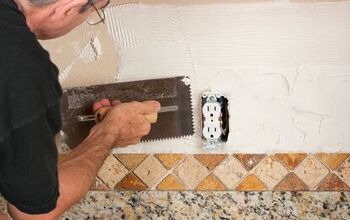Can You Mount A Curved TV On The Wall? (Find Out Now!)

Curved TVs are not as popular as they were when they first came on the scene a couple of years ago. Although sales numbers didn’t quite measure up to industry expectations, these screens still offer a very immersive experience that many choose to include in their home theaters. Whether you just purchased a fancy new curved TV or you’re considering adding one in your home, one main question often comes to mind: Can you mount a curved TV on the wall?
In most cases, curved TVs can be mounted on the wall. Since only the screen itself is curved, and not the rest of the TV, you can mount most curved TVs. However, some of the original curved TV models were not designed for mounting and there’s simply no way around that issue.
With that said, let’s dive deeper into the world of curved TVs, including their pros and cons, how to know if your curved TV can be mounted, whether or not they require a special mount, and more.
Do You Need a Wall Mount Installation Service?
Get free, zero-commitment quotes from pro contractors near you.

Can You Mount a Curved TV on the Wall?
The answer to this question can be a little more complicated than it seems. While most curved TVs can be hung on the wall, it actually depends on the specific model you have and the mount you intend to use. In most cases, only the screen on curved TVs is curved, which makes the mounting process similar to a standard flat screen.
However, another question to consider is whether or not wall mounting your curved TV will look appealing in your space. After all, the concept of wall mounting was created to ensure that flat-screen TVs were as unobtrusive as possible. When you consider the shape of curved TVs, wall mounting one will result in the curved ends sticking out on both sides.
While this may be perfectly fine for your purposes, make sure you measure exactly how far the TV will curve outwards before you make the choice between wall-mounting or using a TV stand.
Advantages and Disadvantages of Curved TV Screens
The major advantage of opting for a curved TV in your home theater is that it places viewers in the center of the action. The theory behind these TVs is similar to that of IMAX theaters, wherein the curve of the screen wraps around the viewers and makes it feel like they are fully immersed in the story. However, while IMAX screens are big enough to encompass the entire seating space, it’s impossible to recreate that experience at home with a curved TV screen.
Since the TV is smaller, the curve is also smaller and only the viewers that are sitting right in the center will enjoy the best viewing experience. This position is referred to as the “sweet spot,” located right in front of the screen and closer than conventional viewing distance for flat screens. Anyone sitting outside of the “sweet spot” simply won’t enjoy the benefits that come with a curved TV. When you increase your distance from the center, you’ll start to have unsightly reflections and even picture distortion.
Curved TVs that are less than 65 inches will only do what they’re advertised to do when you’re watching TV by yourself and sitting in the proper position. You’ll need a screen that is 65 inches or bigger for a group of people to enjoy the immersion that comes with curved TVs. With this in mind, most TV mounts can only handle screens with a maximum size of 70 inches.
So, if you want to get the most out of your curved TV and have it mounted on the wall, you’ll only be able to choose a size between 65 and 70 inches. Of course, it may be possible to hang larger curved TVs on the wall, but they will require professional installation.
How to Know If Your Curved TV Can Be Wall-Mounted
When curved TVs were first invented, those that were available from LG and Samsung were not designed to be wall-mounted. Unfortunately, there is no way to work around this flaw. However, most curved TVs that were manufactured after 2015 are compatible with standard wall mounts and, thus, can be hung on the wall.
If you’re unsure what year your curved TV was manufactured, look out of VESA mounting hardware. VESA is the industry standard for TV mounting, which features screw holes in distinct locations on the bracket. Then, you’ll need to make sure that you select a TV mount that is VESA-compliant.
Do Curved TVs Require a Special Mount?
Most curved TVs do not require a special type of mount to be hung on the wall. Nearly any mount or bracket that is rated as being compatible with your TV model will work, but there are some that work better with curved TVs than others. For instance, some low-profile mounts are engineered to keep screens as close to the wall as possible – referred to as fixed mounts.
These mounts don’t offer the ability to swivel or tilt the screen, resting pretty much flat on the wall. Although they are affordable and easy to install, fixed mounts do not have an arm that extends from them, which makes it difficult to connect a curved TV. Tilt and swivel mounts are more accommodating, offering the option to view the TV from multiple angles. Whereas, a full-motion mount is the ideal choice.
Determining Your TVs VESA Measurements
As previously mentioned, VESA is a standard used for TV wall mounts and mounting systems that has been adopted by the majority of TV manufacturers. In order to find the right VESA mount for your curved TV, you need to know its VESA measurements.
VESA specifications, referred to simply as VESA size (or pattern) designates the position of the four mounting holes on the rear of your TV. In most cases, you’ll be able to locate your TV’s VESA measurements in the manual or on the manufacturer’s website. However, if either option doesn’t work, you can calculate the measurements yourself:
- Measure horizontally between the centers of the right and left holes. This is your first measurement.
- Then, measure vertically between the centers of the top and bottom holes, yielding your second measurement.
- If measuring in inches, convert to millimeters by multiplying by 25.4 mm (1 inch is 25.4 mm).
VESA specifications are usually listed in millimeters and are displayed with the horizontal measurement first, followed by the vertical measurement. For instance, if your curved TVs mounting holes measure 400 mm across and 200 mm high, the VESA size will be indicated as 400×200. Generally speaking, the larger the TV, the larger the VESA measurements will be.
Without your TV’s VESA measurements, you could risk purchasing an incompatible mount and make the process all the more difficult on yourself. So, make sure that you find out the VESA size before you start shopping for a mount for your curved TV.
Do You Need a Wall Mount Installation Service?
Get free, zero-commitment quotes from pro contractors near you.

Final Thoughts
Depending on your curved TV’s specific model, mounting it follows the same simple process as mounting a standard flat screen. Provided that your TV was manufactured after 2015 and you know its VESA size, you should have no trouble finding a compatible mount. When in doubt, you can also seek out the help of a professional to mount your curved TV for you!

Jessica considers herself a home improvement and design enthusiast. She grew up surrounded by constant home improvement projects and owes most of what she knows to helping her dad renovate her childhood home. Being a Los Angeles resident, Jessica spends a lot of her time looking for her next DIY project and sharing her love for home design.
More by Jessica Stone



























